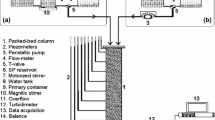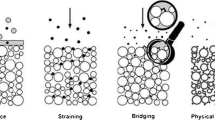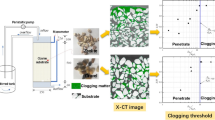Abstract
A study was undertaken on physical clogging of a porous medium by injecting suspended particles (SP), ranging in diameter from 1.7 to 40 μm, into a sand-filled column. Long-term tracer tests were carried out at various flow velocities. Retention of the SP is significantly influenced by the flow velocity. At low flow velocities, retention is confined to a limited length of porous medium, from the entrance of the column, leading to a substantial modification of the hydraulic characteristics of the porous medium. However, at high flow velocities, a much greater length of the porous medium is affected. Particle-size analyses indicate that the particle-size distribution (PSD) of recovered particles changes with time, while the PSD of retained particles changes with depth and time. At the beginning of the filtration process, larger particles were mainly retained at the column entrance. As the injection volume increases, the larger particles penetrate more deeply into the porous medium, and the size of particles observed in the effluent gradually increases. This study highlights the influence of flow velocity, duration of filtration, and the particles’ polydispersity, on the hydraulic characteristics of the porous medium.
Résumé
Une étude a été menée sur le colmatage physique d’un milieu poreux par injection de particules en suspension, dont les diamètres varient de 1.7 à 40 μm, dans une colonne de sable. Des essais de traçage à long terme ont été effectués à différentes vitesses d’écoulement. À faibles vitesses d’écoulement, la rétention est limitée à l’entrée de la colonne et conduit à une modification importante des caractéristiques hydrauliques du milieu poreux. A des vitesses d’écoulement élevées, une longueur beaucoup plus grande du milieu poreux est affectée par la rétention. Les analyses granulométriques montrent que la distribution de taille des particules restituées à la sortie du milieu poreux évolue avec le temps, tandis que la distribution de taille des particules retenues dans le milieu change avec la profondeur et le temps. Au début de la filtration, les grosses particules sont principalement retenues à l’entrée de la colonne. Avec l’augmentation du volume injecté, les grosses particules pénètrent plus profondément dans le milieu poreux, et la taille des particules restituées dans l’effluent augmente progressivement. Cette étude met en évidence l’influence de la vitesse d’écoulement, la durée de la filtration et la polydispersité des particules sur les caractéristiques hydrauliques du milieu poreux.
Resumen
Se llevó a cabo un estudio sobre la obstrucción física de un medio poroso mediante la inyección de partículas en suspensión (SP), cuyo diámetro varía desde 1.7 a 40 micrones, en una columna rellenada con arena. Se realizaron de larga duración ensayos con trazadores a distintas velocidades de flujo. La retención de las SP está significativamente influenciada por la velocidad del flujo. A bajas velocidades de flujo, la retención está limitada por la longitud del medio poroso a partir de la entrada en la columna, conduciendo a una modificación sustancial de las características hidráulicas del medio poroso. Sin embargo, a altas velocidades una longitud mucho mayor del medio poroso se ve afectado. El análisis del tamaño de partícula indica que la distribución del tamaño de partícula (PSD) de partículas recuperadas cambia con el tiempo, mientras que el PSD de las partículas retenidas cambia con la profundidad y el tiempo. Al comienzo del proceso de filtración, las partículas mayores fueron principalmente retenidas en la entrada de la columna. A medida que el volumen de la inyección se incrementa, las partículas más grandes penetran más profundamente en el medio poroso, y el tamaño de partículas observadas en el efluente aumenta gradualmente. Este estudio resalta la influencia de la velocidad de flujo, la duración del filtrado, y la polidispersidad de las partículas, sobre las características hidráulicas del medio poroso.
ملخص
أجريت دراسة على الانسداد الفيزيائي لوسط نفوذ عن طريق حقن جزيئات معلقة والتي تتراوح أقطارها بين 1.7 إلى 40 ميكرون في أنبوب اسطواني مملوء بالرمل. تم إجراء تجارب لتتبع مسار الجزيئات على المدى الطويل بسرعات جريان مختلفة. في التجارب التي أجريت بسرعات جريان منخفضة, يكون احتجاز الجزيئات محدود في مدخل الأنبوب ويؤدي إلى تغيرات هامة في المواصفات الهيدروليكية للوسط النفوذ. أما في السرعات المرتفعة للجريان, يكون طول الوسط النفوذ المتأثر باحتجاز الجزيئات أكبر بكثير. التحاليل الحبية تظهر أن توزع حجم الجزيئات المستردة في مخرج الوسط النفوذ يزداد مع الزمن, بينما حجم الجزيئات المحتجزة في الوسط تتغير مع العمق و الزمن. في بداية الترشيح تكون الجزيئات الكبيرة الحجم بشكل أساسي هي المحتجزة في مدخل الأنبوب. مع ازدياد زمن الحقن )الحجم المحقون(, الجزيئات كبيرة الحجم تخترق إلى أعماق أكبر في الوسط النفوذ, وأقطار الجزيئات المستردة في المخرج يزداد بشكل مستمر. هذه الدراسة توضح تأثير سرعة الجريان, مدة الترشيح, التشتت المتعدد لأقطار الجزيئات المحقونة على المواصفات الهيدروليكية للوسط النفوذ.
摘要
进行了一项多孔介质的物理阻塞实验研究,通过向填满沙子的柱子中注入直径在1.7 到40 μm之间的悬浮颗粒来达到阻塞的目的。在不同的流速条件下进行了长期的示踪试验。流速对残留颗粒的影响非常显著。在低流速的时候,残留颗粒被限制在多孔介质的有限长度段内,这导致从柱子的入口处开始,多孔介质的水力特征就发生了重大的变化。然而,在高流速的时候,多孔介质中更长的距离段内都受到了影响。颗粒大小分析表明回收的颗粒的大小分布随时间会发生变化,而残留颗粒的大小分布会随着时间和深度发生变化。在过滤实验的起始阶段,大颗粒主要残留在柱子的入口处。随着注入颗粒的增加,大颗粒会渗入到多孔介质的更深处,流出液中观察到的颗粒的尺寸也会渐渐变大。本次研究突出的表明了流速,过滤持续的时间和颗粒的多分散性对多孔介质水力特征的影响。
Resumo
Foi desenvolvido um estudo sobre o processo físico de obstrução de um meio poroso através da injecção de partículas suspensas (PS), com diâmetros entre 1.7 e 40 μm, numa coluna de areia. Foram feitos testes de traçadores de longa duração com diferentes velocidades de fluxo. A retenção das PS é significativamente influenciada pela velocidade do fluxo. A baixas velocidades de fluxo, a retenção é confinada a um comprimento limitado do meio poroso, a partir da entrada da coluna, o que conduz a uma alteração substancial das características hidráulicas do meio poroso. No entanto, a elevadas velocidades de fluxo o meio poroso é afectado ao longo de um comprimento muito maior. As análises granulométricas mostram que a distribuição granulométrica (DG) das partículas recuperadas muda com o tempo, enquanto a DG das partículas que ficam retidas muda com a profundidade e o tempo. No princípio do processo de filtração as partículas maiores ficam retidas sobretudo perto da entrada da coluna. À medida que o volume injectado aumenta, as partículas maiores penetram mais fundo no meio poroso e a dimensão das partículas observadas no efluente aumenta gradualmente. Este estudo realça a influência que a velocidade de fluxo, a duração da filtração e a polidispersividade das partículas têm nas características hidráulicas do meio poroso.











Similar content being viewed by others
References
Ahfir N-D, Wang HQ, Benamar A, Alem A, Massei N, Dupont J-P (2007) Transport and deposition of suspended particles in saturated porous media: hydrodynamic effect. Hydrogeol J 15:659–668
Ahfir N-D, Benamar A, Alem A, Wang HQ (2009) Influence of internal structure and medium length on transport and deposition of suspended particles: a laboratory study. Transp Porous Med 76:289–307
Archie GE (1942) The electrical resistivity log as an aid in determining some reservoir characteristics. Trans AIME 146:54–67
Bai R, Tien C (2000) Effect of deposition in deep-bed filtration: determination and search of rate parameters. J Colloid Interface Sci 231:299–311
Boller MA, Kavanaugh MC (1995) Particle characteristics and headloss increase in granular media filtration. Water Res 29:1139–1149
Bouwer H (2002) Artificial recharge of groundwater: hydrogeology and engineering. Hydrogeol J 10:121–142
Bradford SA, Yates SR, Bettahar M, Simunek J (2002) Physical factors affecting the transport and fate of colloids in saturated porous media. Water Resour Res. doi:10.1029/2002WR001340
Bradford SA, Simunek J, Bettahar M, Van Genuchten MT, Yates SR (2003) Modeling colloid attachment, straining, and exclusion in saturated porous media. Environ Sci Technol 37:2242–2250
Bradford SA, Tadassa YF, Pachepsky Y (2006) Transport of Giardia and manure suspensions in saturated porous media. J Environ Qual 35:749–757
Brovelli A, Malaguerra F, Barry DA (2009) Bioclogging in porous media: model development and sensitivity to initial conditions. Environ Model Softw 24:611–626
Brown DG, Stencel JR, Jaffé PR (2002) Effect of porous media preparation on bacteria transport through laboratory columns. Water Res 36:105–114
Compere F, Porel G, Delay F (2001) Transport and retention of clay particles in saturated porous media: influence of ionic strength and pore velocity. J Contam Hydrol 49:1–21
de Marsily G (1986) Quantitative hydrogeology: groundwater hydrology for engineers. Academic, New York
Detay M (1993) Le forage d’eau: Réalisation, entretien, réhabilitation [Water drilling: realisation, maintenance, rehabilitation]. Masson, Paris
Hand VL, Lloyd JR, Vaughan DJ, Wilkins MJ, Boult S (2008) Experimental studies of the influence of grain size, oxygen availability and organic carbon availability on bioclogging in porous media. Environ Sci Technol 42:1485–1491
Herzig JP, Leclerc DM, Le Goff P (1970) Flow of suspension through porous media: application to deep bed filtration. Indian Eng Chem 62:8–35
Jegatheesan V, Vigneswaram S (2000) Transient stage deposition of submicron particles in deep bed filtration under unfavourable conditions. Water Res 34:2119–2131
Johnson WP, Xiqing L, Shoeleh A (2007) Deposition and re-entrainment dynamics of microbes and non-biological colloids during non-perturbed transport in porous media in the presence of an energy barrier to deposition. Adv Water Resour 30:1432–1454
Kehat E, Lin A, Kaplan A (1967) Clogging of filter media. Ind Eng Chem Process Des Dev 6:48–55
Khilar KC, Fogler HS (1984) The existence of a critical salt concentration for particle release. J Colloid Interface Sci 101:214–224
Lee J, Koplik J (2001) Network model for deep bed filtration. Phys Fluids 13:1076–1086
Mays DC, Hunt JR (2005) Hydrodynamic aspects of particle clogging in porous media. Environ Sci Technol 39:577–584
Mays DC, Hunt JR (2007) Hydrodynamic and chemical factors in clogging by montmorillonite in porous media. Environ Sci Technol 41:5666–5671
McGechan MB, Lewis DR (2002) Transport of particulate and colloid-sorbed contaminants through soil, part 1: general principles. Biosyst Eng 83:255–273
Moghadasi J, Müller-Steinhagen H, Jamialahmadi M, Sharif A (2004) Theoretical and experimental study of particle movement and deposition in porous media during water injection. J Petrol Sci Eng 43:163–181
Ochi J, Vernoux J-F (1999) A two-dimensional network model to simulate permeability decrease under hydrodynamic effect of particle release and capture. Transp Porous Med 37:303–325
Reddi LN, Xiao M, Malay GH, Lee IM (2005) Physical clogging of soil filters under constant flow rate versus constant head. Can Geotech J 42:804–811
Roque C, Chauveteau G, Renard M, Thibault G, Bouteca M (1995) Mechanisms of formation damage by retention of particles suspended in injected water. Eur Formation Damage Conference, The Hague, SPE paper 30110, SPE, Tulsa, OK
Saripalli KP, Sharma MM, Bryant SL (2000) Modeling injection well performance during deep-well injection of liquid wastes. J Hydrol 227:41–55
Sen TK, Khilar KC (2006) Review on subsurface colloids and colloid-associated contaminant transport in saturated porous media. Adv Colloid Interface Sci 119:71–96
Shellenberger K, Logan BE (2002) Effect of molecular scale roughness of glass beads on colloidal and bacterial deposition. Environ Sci Technol 36:184–189
Tong M, Johnson WP (2006) Excess colloid retention in porous media as a function of colloid size, fluid velocity, and grain angularity. Environ Sci Technol 40:7725–7731
Torkzaban S, Bradford SA, Walker SL (2007) Resolving the coupled effects of hydrodynamics and DLVO forces on colloid attachment in porous media. Langmuir 23:9652–9660
Veerapaneni S, Wiesner MR (1997) Deposit morphology and head loss development in porous media. Environ Sci Technol 31:2738–2744
Vigneswaran S, Suazo Ronillo B (1987) A detailed investigation of physical and biological clogging during artificial recharge. Water Air Soil Pollut 35:119–140
Wegelin M (1996) Surface water treatment by roughing filters: a design, construction and operation manual. Swiss Federal Institute for Environmental Science and technology (EAWAG) and Department Water and Sanitation in Developing Countries (SANDEC), Dübendorf, Switzerland
Xu SP, Saiers JE (2009) Colloid straining within water-saturated porous media: effect of colloid size nonuniformity. Water Resour Res. doi:10.1029/02008WR007258
Zamani A, Maini B (2009) Flow of dispersed particles through porous media: deep bed filtration. J Petrol Sci Eng 69:71–88
Zhang S, Tan RBH, Neoh KG, Tien C (2000) Electrofiltration of aqueous suspension. J Colloid Interface Sci 228:393–404
Acknowledgements
The authors would like to thank the Associate Editor and the anonymous reviewers for their valuable comments and constructive criticism to improve the manuscript.
Author information
Authors and Affiliations
Corresponding author
Rights and permissions
About this article
Cite this article
Alem, A., Elkawafi, A., Ahfir, ND. et al. Filtration of kaolinite particles in a saturated porous medium: hydrodynamic effects. Hydrogeol J 21, 573–586 (2013). https://doi.org/10.1007/s10040-012-0948-x
Received:
Accepted:
Published:
Issue Date:
DOI: https://doi.org/10.1007/s10040-012-0948-x




